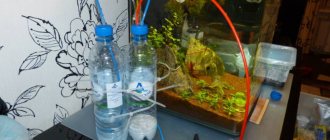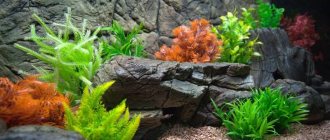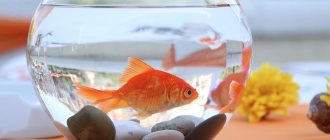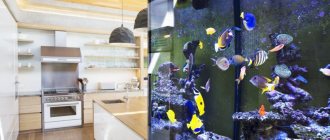Quickly navigate to the article
- 1 Why is it necessary and what should be the correct flow in an aquarium?
- 2 How to create an artificial current
- 3 How to reduce the flow from the filter in an aquarium 3.1 Other interesting articles
Many novice aquarists, when arranging a fish tank, lose sight of such an essential aspect as the movement of water in the aquarium. But the current is one of the most important factors for maintaining a normal aquatic environment in the reservoir for the well-being of all underwater inhabitants. In this article we will look at why it is necessary and how to properly adjust the movement of water in an aquarium.
Why is it necessary and what should be the correct flow in an aquarium?
The movement of liquid in a tank performs a number of important functions:
- By mixing water from different layers, the overall temperature in the aquarium is equalized.
- The formation of a protein film on the surface of the tank is reduced, resulting in improved gas exchange with the air. Improving microflora. Many pathogenic bacteria are anaerobes, therefore, when the bottom layer of water is enriched with oxygen, their activity is inhibited, and the activity of beneficial bacteria (denitrifiers), on the contrary, increases.
- Reducing the amount of ammonia and nitrites in water.
- Enriching the liquid with oxygen and reducing the amount of carbon dioxide.
- Filtration is improved due to the absence or reduction of “dead zones” in the aquarium.
However, in each specific case, you need to proceed from the type, size and characteristics of your tank and, most importantly, from the needs of its inhabitants (not only fish, but also plants). For example, there are breeds of fish that live in fast-flowing waters (iris, labeo, some cichlids, etc.).
For them, the active movement of liquid in the aquarium will be of critical importance. But for fish that naturally live in stagnant waters (for example, labyrinth fish), a strong current will be harmful and even dangerous.
Important! When arranging the flow in an aquarium, you should be guided by the following rule: in herbalists, the flow should be minimal (no more than 1 volume per hour), in fish aquariums it can be made stronger, based on the natural needs of the fish (about 5 volumes per hour).
Therefore, when selecting neighbors in a common aquarium, you must take into account the natural needs of your pets and place together only those species for which the conditions of detention are similar.
Negative effects of too much flow in an aquarium:
- Increased growth of “blackbeard” - red algae of the genus Compsopogon (occurs due to excessive aeration and high content of organic substances).
- Difficulty in feeding.
- Weakening, deterioration in the well-being and health of many species of fish.
- Unfavorable environment for fish breeding - due to the strong water flow, they are physically unable to equip nests for spawning.
- Washing of soil and an increase in the amount of mechanical suspension in the water column (especially dangerous when using fine sand-like soil). It follows that in tanks with strong currents, very powerful, thorough mechanical filtration is needed.
Full and partial water change
Any aquarium may sometimes require a complete water change. This is a serious matter, leading to a complete change of biotope - it’s not for nothing that experienced owners call it a restart.
This is a lot of stress for fish, so there are good reasons for a complete water change:
- an infectious disease has been detected in the aquarium;
- the container has been attacked by a fungus or a severe algae outbreak has occurred, and no other means help;
- There is a massive death of fish or shrimp.
- siltation has reached a critical level, so siphoning the soil is clearly not enough.
If no serious signs indicating the need for a complete replacement are detected, the aqua can go for years without a complete replacement. In this case, the key role is played by periodic partial substitutions.
How to create an artificial current
If you decide that your tank needs flow, there are several ways to organize it.
- Installation of a compressor to organize an “air wall”. This method is perfect for small tanks with a volume of up to 20 liters. With this method, the protein film is effectively removed, and active gas exchange with the air occurs.
- Installing a filter that will “drive” water. In this case, the formation of flow is a bonus from the operation of the purifier. This method often cannot provide the required water flow in large tanks.
- Installation of a special pump. This device is directly designed to create a flow in the aquarium, mix different layers of water, and if you use a foam tube together with a pump, then this device will also replace a mechanical cleaner. This method will be effective for large aquariums. You need to choose a pump based on its size, the type of fish and plants, and the performance of the device (measured in l/hour). Many modern pumps have power regulators, which make it very convenient to control the flow rate.
If the water flow in the aquarium is quite strong, you need to design the tank according to certain rules:
- It is better to choose coarse rocky soil.
- Plants must have a strong root system and tolerate strong flows well. You can also choose mosses that grow on driftwood.
- All underwater decor must be securely fixed in the substrate.
The main rules for proper water changes
There are general principles according to which most aquarists change water. They are universal and aimed at bringing maximum benefit:
. A larger amount of water will already be felt by the fish as a tangible change in the balance, which means it can lead to stress and illness.
You need to fill no more than 25% of the total volume- The water must be prepared in a certain way . For most regions, regular cold tap water, pre-settled or otherwise purified, is suitable. In case of extreme hardness, it must be mixed with filtered or distilled water to reduce the hardness.
- The temperature of the water supplied to the aquarium should be the same as the bulk . This will help avoid discomfort for the inhabitants, especially capricious fish native to South America, which react sharply to changes in the parameter even by a couple of degrees.
Arend van den Nieuwenhuizen
Aquascaper
You should not pour water into the aquarium that is purified using ion-exchange and silver-containing filters. The best option is purification using a reverse osmosis system. This water is completely neutral and does not contain foreign impurities. However, it is also not worth pouring it in its pure form - then there will be a lack of salts, the hardness will be reduced, which has a bad effect on the plants. It is best to mix it in the required proportions with tap water, measuring the hardness Gh of the latter.
— Arend van den Nieuwenhuizen Aquascaper
How to reduce filter flow in an aquarium
The water flow from the filter should be reduced in the following cases:
- In a herbal aquarium, there is a strong disturbance of the vegetation, the plants lean to one side and to the bottom or are completely torn out of the ground.
- The fish is limply carried aside by the water. They swim, strongly resisting the flow, or do not move at all and sit in places with the weakest water flow (“dead zones”), but such low activity is unusual for the species.
- The soil is being washed away.
- The growth of red algae has increased.
Did you know? One of the most famous ocean currents, the Gulf Stream, transports about 75 million tons of water in 1 second. But the most powerful ocean current—the Western Wind Current—carries over 200 million tons of liquid every second!
Many aquarists prefer to make a flute from improvised or easily accessible materials: small-diameter PVC tubes (10–12 mm), an adapter for a filter (you can use a silicone flange) and suction cups for attaching to the walls of the tank.
The required number of holes is drilled on the tube over the entire surface, one end of the tube is attached to the filter using an adapter, the other end must be closed with a plug (it is not recommended to solder it, since the tube will need to be washed periodically). If necessary, the tube can be bent to give it the desired shape , gradually heating it with a hairdryer.
Important! The number and diameter of the holes must be selected in such a way as to allow the entire volume of water to pass freely at the set filter power.
Other ways to reduce flow:
- If your filter model is equipped with a power regulator, you can simply try to reduce it.
- You can rotate the filter tube so that the stream of water breaks on the glass of the aquarium.
- Plug the filter outlet with a fine-pored sponge. According to aquarists, the sponge does not clog even over time, but effectively reduces the flow power.
Thus, properly organized water flow in the tank is a very important factor in the comfort of all fauna and flora in your underwater world.
Other interesting articles
- How to lower the pH in an aquarium with plants* pH in an aquarium The pH value or pH in an aquarium characterizes the acidic properties of the biosystem. Compliance with it...
- What fish can live without aeration, air in the aquarium? What fish can survive without oxygen and filtration? No living creature can live without...
- Why do plants in an aquarium die? Why do plants in an aquarium rot and get sick, and how to avoid it Since you are reading this...
Planting aquarium plants
When placing vegetation, adhere to the following rules:
- The plants are processed and dead and damaged leaves are removed. The roots are trimmed to 2-3 cm long.
- Low vegetation is planted in wet soil and a little water is poured.
- If planting takes a long time, the vegetation is moistened with a spray bottle.
- Plants with red colors are planted in the most illuminated places.
It is recommended to choose inexpensive, hardy plants for the first start of the aquarium, such as ferns, hornwort, and vallisneria. You will need a lot of them: the more, the better. If there is not enough, the space will be filled with algae. When the biological balance is established, excess vegetation is removed.
Landing sequence:
- Mosses are first in line, if provided. They are tied with fishing line to snags and stones.
- In the foreground is ground cover vegetation. The bushes are divided into small ones and planted every 1 cm.
- Fill the middle part with higher specimens.
- Plants with long stems are planted in bunches. They're in the background.
Having finished planting, tablets are applied under the roots to speed up rooting. Many aquarists recommend Tetra Planta Start. Doses according to manufacturer's recommendations.
Biological filtration
Biological filtration is a term that means promoting the growth of bacteria that neutralize ammonia. There are several types of bacteria that convert ammonia into less toxic substances - nitrites and nitrates. These bacteria are not harmful and are quite numerous in nature. They are so common that we do not need to specifically add them to the aquarium - nature does it for us.
In the presence of ammonia and oxygen, these bacteria will naturally multiply. They live throughout the aquarium: on rocks, gravel and even on decorative elements of the aquarium. These bacteria only require the following conditions:1. A surface on which colonies can form.2. Ammonia for food.3. Oxygen-rich water. This sounds so simple that the question arises: why do we need a mechanical filter?
In fact, if you limit the number of fish that biological filtration can handle, you don't need a mechanical filter. Unfortunately, you cannot support large numbers of fish with natural biological filtration alone.
Over the past few decades, many new types of biological filters have been invented that can greatly increase bacterial colonies to provide biological filtration for your aquarium. Essentially, all of these types of filters provide additional surface area for bacterial colonies to grow and increase oxygen in the water.
Lighting
You should not skimp on lighting, because one of the most important conditions for good vegetation growth. 1 W per liter of water should be enough.
It is best to choose specialized lamps for lighting, but at the first stage you can use any lighting source, which can later be replaced with something suitable.
Fluorescent lamps are most suitable for lighting an aquarium. In most cases, a light source placed on top is sufficient, but if the height of the container is more than 50 cm, then additional lighting sources will be required. Accordingly, you need to take into account the lighting needs of the plants you use.
About activated carbon
You often hear that activated charcoal should not be used in herbal medicine. Allegedly, it binds nutrients, which negatively affects aquarium plants. This is only partly true. In fact, activated carbon binds mainly organic compounds (organics), and not all of them. A list of compounds of interest to aquarists that may or may not be bound by activated carbon:
- Activated carbon does not bind macro: nitrates, phosphates, potassium.
- Activated carbon does not bind metal ions included in microfertilizers.
- Activated carbon binds many chelators such as EDTA, DTPA. Moreover, activated carbon can also bind complexes of these chelates with metals.
- Activated carbon does not bind iron gluconate and other metal gluconates included in microfertilizers. Therefore, you can safely use activated carbon. in aquariums with AQUAYER fertilizers, but it is not advisable to use in the case of homemade fertilizers according to my recipe.
- Activated carbon binds glutaraldehyde.
What is a herbalist
A herbalist is a vessel of water filled with algae and hydrophilic plants. Underwater cultures in it can be located chaotically or be sorted into groups and types, forming an orderly “Dutch” reservoir.
An aquascape is also considered a type of herbalist - a reservoir with an artificial landscape created from plants, stones, driftwood and various decorative elements. Creating this type of floral aquarium is a labor-intensive task that requires in-depth study of various areas of aquarium science and design.
Light
A beautiful and healthy aquarium with live plants requires very powerful light. As practice shows, it is better to have 1-1.5 W/l, taking into account the fact that the aspect ratio of the aquarium is proportional to those indicated above and its depth does not exceed 60 cm. Otherwise, it is necessary to install metal halide lamps. It should be remembered that the wattage per liter of capacity is very relative. If the height of the aquarium is significantly greater than the length and depth, then the above condition cannot be met, because the bottom half of the aquarium will be in semi-darkness. In this case, it would be more correct to calculate the illumination parameter, which is measured in lux (1 Lux = 1 Lumen per square meter), but this calculation is quite complex and it is necessary to take into account a large number of coefficients that you need to know, so it will be easier to rely on the value of 2W /l.
The best option would be to use T5 fluorescent lamps, which have the highest luminous efficiency (i.e., they give off the greatest amount of light from the power consumption). A more budget-friendly option is T8 lamps (necessarily with a metal reflector). Energy-saving light bulbs cannot be used to create a beautiful aquarium with plants, because... they have very low light output with high power consumption.
The power and color temperature of the light flux affect the color of plants and their appearance. For example, a very powerful red light makes it possible to maintain the bright color of young leaves of Echinodorus for a long time, reduces internodes in long-stemmed plants, and increases spreading in rosette plants. You also need to take into account that with such light, green plants may appear red, and dwarf species may stretch out - microranthemum, for example, under metal halide lighting can reach a height of 30 centimeters. I recommend using lamps with peaks in the red (orange-yellow) and violet parts of the spectrum, with a color temperature of 5500 - 6500K.
Daylight hours should last at least 8 hours, and preferably 10-12. And in order to avoid the appearance of algae in the middle of daylight hours, it is necessary to take a lighting break for 1 - 2 hours. Gradually increasing daylight hours increases the likelihood of plants flowering
Soil selection
The choice of soil directly depends on the type of aquarium plants you use. If they have a root system, then they are suitable for planting in the ground - it should be neutral, fairly fine (sand or fines up to 0.5 cm) and light. Only in such conditions will the root system grow and develop. The soil must be purchased in a specialized store, i.e. it should be an aqueous substrate, and not ordinary store-bought soil for potted plants.
The thickness of the soil layer is about 3-5 cm. If the plants are large (for example, echinodorus), then the thickness of the layer should be from 8 to 10 cm. If the greenery is floating, i.e. Since it does not have a root system, such plants can be attached to decor, driftwood or stones.
Question answer
How to achieve less frequent water changes?
Cover the aquarium with glass, do not overcrowd the inhabitants, do not overfeed them.
Are there special means to improve tap water?
Yes, you can buy conditioners in pet stores and online that improve the quality of tap water. However, their use does not exclude settling.
Is it possible to use filtered water?
Only the one that went through carbon filters. Other types of filtration add substances to the water that may be harmful to fish.
How to achieve the desired temperature before replacement?
As the water sits in the room, it will reach the desired temperature within a couple of days. If warmer water is needed, it is heated using a low-power electric spiral heater, stirring constantly.
Do I need to remove fish before changing water?
If the aquarium is small, it is better to move the fish to a fish tank. In large containers with partial replacement, this is not necessary; you just need to cover the siphon tube with a mesh.
Changing water is not that difficult if you approach it wisely and do it right. Over time, it becomes a habit and becomes a kind of ritual.
About water preparation
For most owners, the source of new water is the plumbing system that supplies drinking water.
Freshly poured from the tap, it is not suitable for topping up for a number of reasons:
- High concentration of chlorine . Chlorination of water kills microbes, but is no less harmful to fish, snails and shrimp. Chlorine tends to evaporate, so during the settling process the danger of poisoning can be avoided.
- Saturation of water with gas bubbles . Most often, this is ordinary atmospheric air, which is found in water in the form of tiny bubbles. You can verify this by pouring water into a container and leaving it for several hours: the walls of the container will become covered with many bubbles. During settling, the bubbles stick together, enlarge and burst, rising to the surface.
Excessive saturation of water with air bubbles can lead to gas embolism in fish - the body is covered with small bubbles, the fish behaves restlessly, falls on its side, and the gill covers are closed. Bubbles can clog blood vessels, and this is certain death. Therefore, it is simply necessary to defend the water. The settling time varies from two days to two weeks.
What determine the parameters of purity and transparency?
The purity and transparency of water in an aquarium depends on many criteria:
Volume. The smaller the container, the faster the water evaporates and becomes cloudy. The optimal volume is from 100 l.
Number of fish. The more “overpopulated” an aquarium is, the faster the water becomes polluted with fish waste products and other organic waste. As a result, it becomes cloudy and a film appears on the surface. The average volume of water per fish is 5 liters.
Quality of the filtration system. The type of filter is not important. It can be mechanical, chemical, biological, mixed.
Light and temperature conditions. Bright light and heat provoke the active development of microflora, the water begins to “bloom” and become cloudy.
Presence of algae, snails.
Many of them are useful as “live filters,” but it’s important not to overdo it. An excess of algae simply prevents the fish from moving in the aquarium, and the waste of many snails greatly exceeds the volume of organic matter they process.
Regularity of water changes according to the “age” of the ecosystem.
This is the only way to maintain its optimal biobalance, otherwise the water will inevitably become cloudy, despite the presence of “biological” and other filters and the use of special preparations.
The quality of the water itself. To maintain clarity, tap water requires preliminary preparation before it can be poured into the aquarium. The most popular way is to defend it.
Also, only fish should live in the aquarium. The only acceptable “neighbors” for them are snails. For turtles, newts, and Cuban frogs, you need to purchase a different container.











